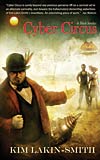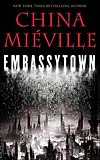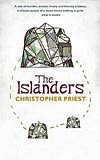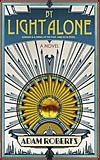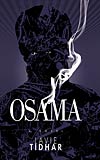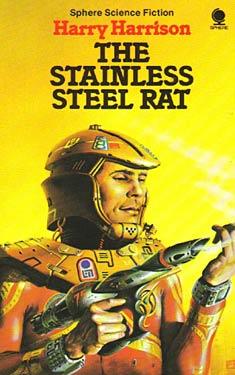2011 BSFA Awards Shortlist Announced
The shortlist for the 2011 British Science Fiction Association Award has been announced. The nominees for Best Novel are:
- Cyber Circus – Kim Lakin-Smith (NewCon Press)
- Embassytown – China Mieville (Del Rey)
- The Islanders – Christopher Priest (Gollancz)
- By Light Alone – Adam Roberts (Gollancz)
- Osama – Lavie Tidhar (P.S. Publishing)
The 2011 awards will be held at Olympus 2012, The 2012 Eastercon, which takes place from 6th – 9th April 2012 at the Radisson Edwardian Hotel, Heathrow, London. Visit the BSFA website for the complete list of nominees in all categories. Congratulations to all the nominees.
What do you think of this list? Any favorites to win?
Gaiman’s Apocalypse
 This week’s entry in our ongoing Genre Poetry series comes from Neil Gaiman’s short story and poetry collection, Fragile Things. What would happen if every genre-spawned apocalypse hit us at once? Would we even notice, or would we finally reach Patton Oswalt’s Etewaf Singularity?
This week’s entry in our ongoing Genre Poetry series comes from Neil Gaiman’s short story and poetry collection, Fragile Things. What would happen if every genre-spawned apocalypse hit us at once? Would we even notice, or would we finally reach Patton Oswalt’s Etewaf Singularity?
The Day the Saucers Came
by Neil GaimanThat day, the saucers landed. Hundreds of them, golden,
Silent, coming down from the sky like great snowflakes,
And the people of Earth stood and
stared as they descended,
Waiting, dry-mouthed, to find what waited inside for us
And none of us knowing if we would be here tomorrow
But you didn’t notice it becauseThat day, the day the saucers came, by some coincidence,
Was the day that the graves gave up their dead
And the zombies pushed up through soft earth
or erupted, shambling and dull-eyed, unstoppable,
Came towards us, the living, and we screamed and ran,
But you did not notice this becauseOn the saucer day, which was the zombie day, it was
Ragnarok also, and the television screens showed us
A ship built of dead-men’s nails, a serpent, a wolf,
All bigger than the mind could hold,
and the cameraman could
Not get far enough away, and then the Gods came out
But you did not see them coming becauseOn the saucer-zombie-battling-gods
day the floodgates broke
And each of us was engulfed by genies and sprites
Offering us wishes and wonders and eternities
And charm and cleverness and true
brave hearts and pots of gold
While giants feefofummed across
the land, and killer bees,
But you had no idea of any of this becauseThat day, the saucer day the zombie day
The Ragnarok and fairies day, the
day the great winds came
And snows, and the cities turned to crystal, the day
All plants died, plastics dissolved, the day the
Computers turned, the screens telling
us we would obey, the day
Angels, drunk and muddled, stumbled from the bars,
And all the bells of London were sounded, the day
Animals spoke to us in Assyrian, the Yeti day,
The fluttering capes and arrival of
the Time Machine day,
You didn’t notice any of this because
you were sitting in your room, not doing anything
not ever reading, not really, just
looking at your telephone,
wondering if I was going to call.
GMRC Review: Tau Zero by Poul Anderson
 Guest Blogger and WWEnd member, valashain, reviews science fiction and fantasy books on his blog Val’s Random Comments which we featured in a previous post: Five SF/F Book Blogs Worth Reading. Val has posted many great reviews to WWEnd and this is his first for the GMRC. Be sure to visit his site and let him know you found him here.
Guest Blogger and WWEnd member, valashain, reviews science fiction and fantasy books on his blog Val’s Random Comments which we featured in a previous post: Five SF/F Book Blogs Worth Reading. Val has posted many great reviews to WWEnd and this is his first for the GMRC. Be sure to visit his site and let him know you found him here.
Note: There be spoilers here!
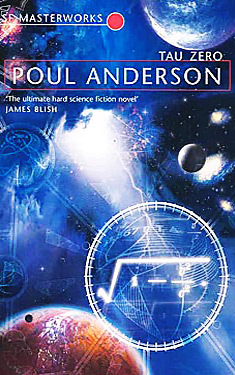 I decided to sign up for the 2012 Grand Master Reading Challenge, organized by World Without End. The goal is to read and review a work by a different Damon Knight Memorial Grand Master Award winner every month. I decided to start with Poul Anderson, who was honoured with the award in 1998. Tau Zero (1970) is one of his better known works. It was nominated for the Hugo Award in 1971 but lost to Larry Niven‘s Ringworld. It is a very good example of hard science fiction, written in a time when the direction of the genre was being drastically changed by the arrival of new age authors. The novel is an expansion of the short story To Outlive Eternity which was first published in Galaxy Science Fiction in 1967. I’m not going to hold back on spoilers in this review, the title of the short story gives is one already anyway. You have been warned.
I decided to sign up for the 2012 Grand Master Reading Challenge, organized by World Without End. The goal is to read and review a work by a different Damon Knight Memorial Grand Master Award winner every month. I decided to start with Poul Anderson, who was honoured with the award in 1998. Tau Zero (1970) is one of his better known works. It was nominated for the Hugo Award in 1971 but lost to Larry Niven‘s Ringworld. It is a very good example of hard science fiction, written in a time when the direction of the genre was being drastically changed by the arrival of new age authors. The novel is an expansion of the short story To Outlive Eternity which was first published in Galaxy Science Fiction in 1967. I’m not going to hold back on spoilers in this review, the title of the short story gives is one already anyway. You have been warned.
Fifty men and women are sent on the spaceship Leonora Christine to explore and, if possible, colonize a planet more than thirty light years away. To make the trip in a reasonable span of time, the spaceship has to approach the speed of light and make use of the time dilation effects that become appreciable at such speeds. Before deceleration can be set in, the engines needed to slow down the ship are severely damaged. Repairing them would mean shutting the acceleration engines off as well, which would result in a quick death from intense radiation. The ship’s speeds keeps increasing, hurling the crew ever faster through space and time. Unless they can find a way to slow down the crew is doomed to live out their life on board the space ship.
Tau Zero is science fiction so hard it cuts diamonds. A physics lesson and a novel rolled into one. The publisher kindly provided the formula for the time contraction factor Tau, which equals the square root of 1 minus v squared divided c squared, where v stand for velocity and the constant c is the speed of light. In other words Tau equals zero when v equals c (everybody still with me?). In a more practical sense, the closer the speed of the ship gets to the speed of light, the larger the difference between time passing for the crew and time passing outside the ship. I understand that Anderson’s use of Tau is a bit unorthodox but for narrative purposes it serves very well.
In a way, Anderson uses Tau to show us just how large the universe really is, something he is rather fond of doing in his other science fiction novels as well. As the velocity of the ship approaches the speed of light, minutes, hours, days, years and eventually aeons pass for every second of ship time. Galaxies are crossed, then clusters and super clusters to the point where time and distance becomes meaningless. In the end, Anderson takes us to the death of the universe itself and there a bit of speculation seeps in. The debate about the eventual fate of the universe is still raging, Anderson assumes the universe is cyclic and will eventually contract into a new singularity and expand again after a big bang. Although science has not come up with the proof for this yet, in literature the death and rebirth of the universe does make for a wonderful theme.
That’s quite a lot of physics and cosmology for the reader to take in. The more experience science fiction reader will have come across these elements before. Alastair Reynolds for instance, includes much more exotic science into his works. Anderson explains the physics clearly, even the more counter intuitive elements of relativity, but spares us quantum mechanics. Personally, I enjoyed the scientific passages a lot. That is my personal taste however; it will no doubt put some readers to sleep in a few pages. This novel requires some interest in physics and cosmology to really appreciate.
One might think that this would be enough science for a single novel but Anderson also throws in quite a lot of detail about the Bussard engine of the spaceship. This theoretical way of propelling a ship was first proposed in 1960 and has appeared in a number of science fiction novels by such authors as Larry Niven and Carl Sagan. It is basically a fusion engine which uses the minute quantities of free hydrogen in space to propel the ship. There has been a lot of debate about whether or not a ship powered in such a way would actually be able to reach relativistic speeds, but it’s an ingenious idea anyway. Again Anderson explains the design of the engine and its limitations, which play a large part in the efforts to slow the ship down, very clearly. I thought the engineering was a bit less interesting than the cosmology but it is central to the plot and Anderson makes sure not to overdo it.
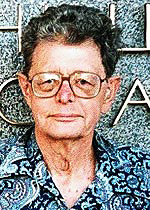 Hard science fiction has a reputation of paying less attention to character and character development. For Tau Zero that is definitely true. I guess you could consider the two people we meet in the opening chapter, the compassionate Ingrid Lindgren and the brusque Charles Reymont to be the main characters. They appear to be the people who keep the crew together and sane as Earth becomes an ever more distant memory. They are mostly people dealing with problems of the crew’s morale and organizing efforts to solve their technical problems. Although towards the end of the book things get a bit more philosophical (the death and rebirth theme does have an effect on them), there is very little in the way of development in their characters.
Hard science fiction has a reputation of paying less attention to character and character development. For Tau Zero that is definitely true. I guess you could consider the two people we meet in the opening chapter, the compassionate Ingrid Lindgren and the brusque Charles Reymont to be the main characters. They appear to be the people who keep the crew together and sane as Earth becomes an ever more distant memory. They are mostly people dealing with problems of the crew’s morale and organizing efforts to solve their technical problems. Although towards the end of the book things get a bit more philosophical (the death and rebirth theme does have an effect on them), there is very little in the way of development in their characters.
Most of the novel is set in space so the future history of Earth is not all that important. We do get a glimpse of a society where Sweden has become the centre of power in the world after a nuclear war that almost doomed the planet. IKEA everywhere, surely this must count as a dystopia. Anderson, American of Danish descent, also weaves in some reverences to Scandinavian mythology, something that returns in many of his novel. It’s a bit of an odd contrast really, the cyclic nature of the universe as described in this novel, reminded me more of Hindu mythology.
According to the blurb on the cover, James Blish considers this book the ultimate hard science fiction novel. There is something to be said for that. I have rarely read a novel with such rigorous scientific underpinnings. Anderson had a degree in physics and in other novels it is quite clear that he thought about the properties of fictional planets he created. In Tau Zero he takes it way beyond that and makes physics the main character. The scope of the novel, in time and space is almost beyond comprehension (something the author points out several times in the text). Anderson takes hard science fiction as far as it will go; in that sense it is the ultimate novel in this particular sub-genre. That being said, it does not escape the shortcomings generally associated with the sub-genre. I’d say it is a must read for fans of hard science fiction only.
The Girl Who Circumnavigated Fairyland in a Ship of Her Own Making by Catherynne M. Valente
Guest Blogger, Allie McCarn, reviews science fiction and fantasy books on her blog Tethyan Books which we featured in a previous post: Five SF/F Book Blogs Worth Reading. She has already contributed many great book reviews to WWEnd and has generously volunteered to write some periodic reviews for our blog. Be sure to check out her site and let her know you found her here.
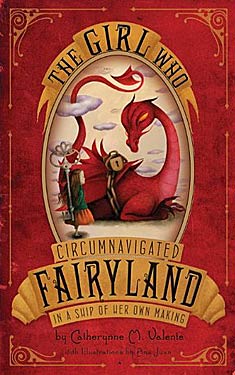 The Girl Who Circumnavigated Fairyland in a Ship of Her Own Making
The Girl Who Circumnavigated Fairyland in a Ship of Her Own Making
by Catherynne M. Valente
Published: Feiwel and Friends, 2011
Series: Fairyland Book 1
Awards Won: Andre Norton Award
The Book:
“Twelve-year-old September is an ordinary girl who lives what seems to her a quiet, constricting life. Her father is gone to war and her mother works, leaving September mostly to herself in their home. One day, the Green Wind arrives, offering to take her away for adventures in Fairyland.
Without a backward glance, September takes him up on his offer. However, for all its wonders, Fairyland is a tricky, dangerous place. September makes new friends as she travels, including a ‘Wyverary’ named A-Through-L and a Marid boy named Saturday. She also finds new enemies, such as the cruel Marquess who has taken over Fairyland after the disappearance of the good Queen Mallow.
Though her journey started as a whim, it is going to take every ounce of resourcefulness, courage, strength and compassion September can muster to see her way to the end of it!” ~Allie
Here is my very late review for the final selection of the Calico Reaction blog’s 2011 book club. This is my first foray into Valente’s work, though I’ve heard a lot of praise for her novels. The Girl Who… was originally a fictional children’s book referenced in Valente’s novel Palimpset. The novel feels complete in itself, though I can certainly see where there are many more stories to tell in this universe. So far, Valente has published a prequel (The Girl Who Ruled Fairyland—For a Little While), and I imagine we’re likely to see more young adult novels set in this world in the future.
My Thoughts:
The basic story of The Girl Who… is pretty familiar—a child is whisked away to a magical land that is plagued by a cruel ruler. In very general terms, it has a lot in common with other children’s classics, such as The Wizard of Oz, The Chronicles of Narnia, or Alice in Wonderland. It also features a technique commonly found in old children’s fiction, where the narrator constantly inserts comments and asides into the flow of the story. The novel, though, seems conscious of the nods it’s making towards previous work, and manages to keep its own spark of originality. For me, the vibrant writing, profusion of imaginative creatures and societies, and unexpectedly serious turns of the plot helped The Girl Who… to stand as a wonderful new example of this familiar kind of story.
In the beginning, the writing was playfully descriptive and more than a little silly (intentionally so—that is not an insult). The writing occasionally felt a little too self-consciously clever and whimsical, but it was not long before I was enjoying the story so much that I didn’t mind. The Girl Who… progressed with an impressive forward momentum that packed a lot of story and subtext into a pretty short novel. September was constantly moving through new situations and problems, and meeting all sorts of new supernatural creatures. These creatures included a wish-granting Marid, a ‘wyverary’ (half-wyvern, half-library), 100+-year-old sentient household objects, a golem made of soap, and many others. I loved the constantly changing setting and never-ending introductions of new beings.
 While the vividly described supernatural elements gave the story a fun and exciting sense of place, it was the characters that really captured my attention. Like most tales of this kind, The Girl Who… combines a fantastical adventure with a story of maturation. In the beginning, September is described as “Somewhat Heartless”, as all children are, though she’s a well-meaning, pleasant heroine. Through her harrowing journey, September is forced to a deeper understanding of herself and the effects of her actions on others. I especially liked how she was confronted with difficult decisions that had no clear ‘right’ response. Like most of us humans, she simply had to move on, carrying nothing but an uneasy and never-confirmed hope that she’d done the right thing. Altogether, September is a fallible, dynamic heroine, and I loved following her story.
While the vividly described supernatural elements gave the story a fun and exciting sense of place, it was the characters that really captured my attention. Like most tales of this kind, The Girl Who… combines a fantastical adventure with a story of maturation. In the beginning, September is described as “Somewhat Heartless”, as all children are, though she’s a well-meaning, pleasant heroine. Through her harrowing journey, September is forced to a deeper understanding of herself and the effects of her actions on others. I especially liked how she was confronted with difficult decisions that had no clear ‘right’ response. Like most of us humans, she simply had to move on, carrying nothing but an uneasy and never-confirmed hope that she’d done the right thing. Altogether, September is a fallible, dynamic heroine, and I loved following her story.
Of course, the wonderful characterization doesn’t end with September. Her closest companions—A-Through-L and Saturday—were also fully formed characters, and I could easily see them starring in their own adventures. In fact, it seemed that everyone and everything in the novel had a strong, memorable personality, all the way down to September’s helpful coat. Even the villain, the Marquess, is far from the cardboard character one might assume her to be at her first entrance into the story. Fairyland is so wide and varied, and filled with such interesting characters, that I am sure Valente can find many different stories to tell there in the future.
My Rating: 4.5/5
The Girl Who Circumnavigated Fairyland in a Ship of Her Own Making is, in my opinion, a children’s novel that has enough depth to be enjoyed by adults. The imagery is amazing, and the characters are memorable and very easy to love. September is a wonderfully tenacious, imperfect heroine, and even the villainess is the hero of her own story. While it has a lot in common with other child-whisked-away-to-magic-world stories, I think this novel’s individual strengths are its lovely writing, creative supernatural world, and the unexpected places Valente takes the story. This novel does feel complete, but it is clear that there are many more stories to be told in Valente’s Fairyland!
GMRC Review: Hunt the Space-Witch!
 Editor’s Note: On his blog Stainless Steel Droppings blogger Carl V. Anderson reviews SF/F books and movies, conducts author interviews and even hosts his own reading challenge: The 2012 Science Fiction Experience. This is Carl’s second Grand Master review already, after The Stainless Steel Rat, and it’s a doozy!
Editor’s Note: On his blog Stainless Steel Droppings blogger Carl V. Anderson reviews SF/F books and movies, conducts author interviews and even hosts his own reading challenge: The 2012 Science Fiction Experience. This is Carl’s second Grand Master review already, after The Stainless Steel Rat, and it’s a doozy!
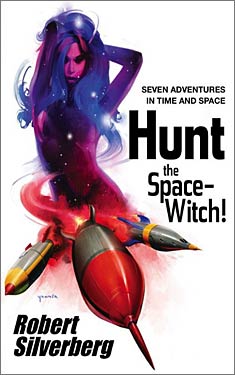 I first became aware of this collection of pulp-era short stories by author Robert Silverberg while perusing the internet last fall. The moment I saw Kieran Yanner’s dynamic retro cover I knew this book would have to be mine. I was reminded of the book when posting about my favorite SFF covers from books published in 2011 and promptly ordered a copy. Over the last two days I have immersed myself in the world of pulp-era science fiction and in so doing have discovered the talent that later propelled author Robert Silverberg to Grand Master status.
I first became aware of this collection of pulp-era short stories by author Robert Silverberg while perusing the internet last fall. The moment I saw Kieran Yanner’s dynamic retro cover I knew this book would have to be mine. I was reminded of the book when posting about my favorite SFF covers from books published in 2011 and promptly ordered a copy. Over the last two days I have immersed myself in the world of pulp-era science fiction and in so doing have discovered the talent that later propelled author Robert Silverberg to Grand Master status.
Pulp-era stories are all too often written off as something of inferior quality and in many ways in a best case scenario the term “pulp” has come to be synonymous with nothing more than guilty pleasure reading. I suspect that there is a great deal of merit in that. Common sense would dictate that in the heyday of pulp magazines publishers were cranking out magazines as fast as they could and authors were expected to follow a formula, write quickly, and be as prolific as possible if they wanted to make a living and keep their work in the public eye. And to be certain there is probably much in the days of pulp science fiction that wasn’t worth reading then and does not merit attention now. By the same token, there are common themes, archetypes, and story structures in pulp adventure stories that resonate with today’s audience. In my childhood it was creators like George Lucas who reached back into the pulp era for inspiration when crafting what would become the pop cultural phenomenon Star Wars. And though some may be loathe to admit it, there is a universality to these tales that are the ancestors of popular stories today.
The stories are often sensational, featuring rugged heroes prone to decisive action, conflict between defined “good guys” and “bad guys”, action over characterization or science, romantic melodrama over reason. These are space yarns, at times little different than their mystery or western counterparts. The setting may be on another planet or on Earth in the far-flung future but the stories themselves are as recognizable to fans of fiction in general as they are to fans of the genre of science fiction.
Planet Stories Books has reprinted 7 of Robert Silverberg’s stories originally published in the short-lived digest Science Fiction Adventures, edited by John Carnell. In the introduction Silverberg sets the stage for what I believe is the proper attitude with which to approach these stories–he relates the story of his first encounter with Planet Stories Magazine and how he found it to be a “treasurehouse of wonders”. He then went on to collect and devour all of the back issues of the magazine. Silverberg relates the circumstances around the creation of these seven stories and where they were originally published and at no time in his introduction does he approach this work with a self-deprecating or apologetic tone. Silverberg remembers the “heady rapture” of the pulp stories of his youth and recalls how both he and Carnell approached Science Fiction Adventures as a way to honor the love they had for Planet Stories.
Please allow me a moment to give a brief synopsis of each novella with my non-spoiler thoughts included.
Slaves of the Star Giants
Lloyd Harkins awakens in a place where quiet, melancholy giants lumber with unknown purpose and 15 foot tall robots crash pell-mell through the woods. Placed unceremoniously in a tribe of barbarians, Harkins soon finds himself at odds with the tribes’ leader and banished back to the savage forest. As events unfold, Harkins begins to suspect that he is merely a pawn in a game much larger than himself and the anger that ignites will lead him to either victory, or to death.
The future-Earth described by Silverberg called to mind other stories that I’ve read, like Jack Vance’s Tales of the Dying Earth and Larry Niven’s A World Out of Time. Technology is akin to black magic to the people who no longer know how to use it or what purpose it had. Some of the nostalgic charm that these older stories often possess was present in this first story mostly in the form of an enormous computer that required tape to be fed into the machine in order to make it function.
Spawn of the Deadly Sea
Earth lies entirely underwater, the result of a long-ago invasion by a mysterious alien race. Humanity exists in two-spheres: the floating cities that are the refuge of the progeny of those that survived the invasion and the vast oceans which are home to the Seaborn, hybrid man-made creatures that were mankind’s last hope to defeat the alien invaders. But alas they were too little, too late. In this far future the world is divided into nine sections of the sea, each ruled over by the Sea-lords, brigands who enact tribute to protect the shipments of goods from one floating city to another. Young Dovirr is tired of city life and longs for the glory he imagines is part of the life of a Thalassarch, ruler of the Sea-lords. With the bravado of untried youth Dovirr gambles and wins a spot on the Garyun, determined to make his dreams of naval conquest a reality. He soon discovers there is more to the sea than the occasional battle with would-be pirates and humanity’s pent up anger over the past alien invasion is just about to find a release.
This story is very much a rousing swash-buckling pirate adventure, yet within those confines it nevertheless touches on some very interesting concepts, like prejudice and mindless obedience. The concept of entire Earth cities being covered and remaining covered with water stirred my imagination and I couldn’t stop the flow of cinematic images of what it would look like to dive these remains.
The Flame and the Hammer
The Emperor of the Galactic Empire is growing old and feeble and grumbles of rebellion from a few wayward planets are beginning to reach his ear. Ras Duyair lives on one of these planets, Aldrynne, the capital planet of a seven planet system. His father, High Priest of the Temple of the Suns has often spoken of the mythological Hammer of Aldrynne, a weapon prophesied to bring down the fall of the Empire. When his father is killed under Imperial interrogation as to the whereabouts of this weapon it soon becomes apparent that the knowledge of what this weapon was or where it can be found has died with him. Ras Duyair flees to a neighboring planet to escape those who believe his father has passed this information down to him and he soon becomes embroiled in a rebellion against the Galactic Empire.
With shades of Isaac Asimov’s Foundation, particularly in the use of an ancient Rome inspired system of government, Silverberg has crafted his version of the tale of a young hero born into obscurity who will rise up to take on an Empire.
Valley Beyond Time
Sam Thornhill lives alone in a peaceful valley, a place of utter tranquility. Or at least he thought he was alone until the arrival of a beautiful woman and a squat man shatter his peace. Soon there are nine people in the valley, six humans and three aliens. As the bliss of Thornhill’s illusions begin to fade he discovers that this majestic valley may not be all that it seems and forces beyond his imagination might never allow any of them to leave.
This is the kind of story you would expect to have been later adapted for an episode of The Twilight Zone. And in some manner it has, for this is a story that has been told many times and in many ways in short story format and also in television shows like the aforementioned Twilight Zone and the various iterations of Star Trek. Despite its familiarity, the themes of freedom and control are as compelling as ever and Silverberg builds the suspense in a satisfyingly deliberate manner.
Hunt the Space-Witch!
When the starship on which Barsac serves lands on the planet Glaurus, he begs leave of his captain to set out to track down an old friend of his to fill a vacant position on the ship. In the years of his absence, Glaurus has become considerably more dangerous and Barsac soon discovers that his friend has gone missing, a possible recruit of the enigmatic Cult of the Space-Witch. As people begin to die around him Barsac becomes more determined to rescue his friend at any cost, even if the cost is his own life.
What sounds as if it would be an incredibly hokey bad-religious-cult story demonstrates that not all pulp stories are created equal and that “space adventures” can sometimes be as dark and sinister and deadly as the cold reaches of space itself.
The Silent Invaders
Major Abner Harris of the Interstellar Development Corps is on his way to Earth for a long overdue vacation. Except that it really isn’t overdue nor is it a vacation. For Major Harris is not really Major Harris, nor is he the Terran male that he appears to be. Harris is really a member of the race of the planet Darruui, a reluctant recruit chosen to infiltrate Earth for reasons that will be revealed as the story unfolds. Harris soon finds he is not alone in his deception and that members of Darruui’s sworn enemy, the Medlin, are also on Earth in the guise of native-born Terrans. In a story worthy of the espionage/counter-espionage of noir detective stories, The Silent Invaders foretells the next stage of the evolution of humanity and examines the lengths people, and aliens, will go to in order to make sure that their self-interests are protected.
This is an interesting addition to the collection because it bucks the tradition of the rest of the stories printed here, and presumably the majority of pulp sf stories, in that it introduces a strong and capable female character into the mix and allows her to be just that. In the introduction Silverberg mentions that he has expanded this story into a novel and I can safely say it is one novel I will be keeping an eye out for.
Spacerogue
Barr Herndon has a grudge, the kind of deep-seated grudge born out of seeing his family murdered and their lands destroyed at the whim of a self-indulgent ruler. Now he is back and it soon becomes apparent that he is looking for revenge and he will stop at nothing, including an almost fanatical devotion to his own gray moral code, to get it.
This is a story of nobles and serfs, a feudal society in a far distant galaxy. More than any other tale in this collection, Spacerogue shocked me. Right from the beginning something happens that I did not see coming and the surprises continue as Herndon gets closer to his desired vengeance.
Hunt the Space-Witch! is not high literature. Deep characterization and exhaustive examination of ideas were not the order of the day. These seven novellas were written with magazine space considerations in mind and were written to capture the imagination and to hopefully infuse a sense of wonder in the reader. They were meant to thrill and to excite. Today they are works of pure nostalgia but at the same time they demonstrate that even at an early age Silverberg was talented and imaginative. The stories may follow a predictable pattern but do not always have predictable endings and I was pleasantly surprised with how often I was shocked with a particular story element or direction a story was taking. Characters made decisions I did not anticipate and there was a degree of ambiguity about some of the protagonists that made it hard to like them even when you were on their side. At the same time there is a comfort that comes with the certain knowledge that the short stories in a collection will all have a definite beginning, middle and end and will not be reliant on something esoteric or ambiguous to lend them credibility or to elicit praise.
It is akin to damning with faint praise to say that a story, or in this case a collection of novellas, is “fun”. However, it is not my intention to denigrate Silverberg’s pulp science fiction tales when I say that they are just that–pure, unadulterated FUN. I picked this collection up late yesterday evening and found myself reading well into the night. I awoke early this morning and immediately started where I left off, finishing it later this afternoon while sitting out on my back porch in warm, un-January-like weather. My disappointment when there were no more stories left to read is a compliment to how much I was entertained by Silverberg’s wonder-filled nostalgic science fiction.
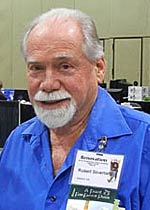 Before I leave off I have to give praise to Planet Stories for their book design. I have already mentioned my affection for the cover art, but what makes the book’s presentation special is the nod to the pulp magazines that inspired Silverberg to write these stories in the first place. From the magazine-style Table of Contents to the ad-filled back pages featuring full-page book art and a retro-style subscription page, this book is an homage to a time when science fiction publishing was so very different than what it is today. I should point out that on the publishing data page it erroneously reports that these stories were previously published separately in Planet Stories magazine. This does not concur with Silverberg’s introduction in which he talks about the untimely (for him) demise of Planet Stories magazine saying, “I never did get a chance to have some grand and gaudy space adventure published in that grand and gaudy magazine”. As mentioned above these stories were published in Science Fiction Adventures magazine. A minor quibble about an otherwise snappy trade paperback.
Before I leave off I have to give praise to Planet Stories for their book design. I have already mentioned my affection for the cover art, but what makes the book’s presentation special is the nod to the pulp magazines that inspired Silverberg to write these stories in the first place. From the magazine-style Table of Contents to the ad-filled back pages featuring full-page book art and a retro-style subscription page, this book is an homage to a time when science fiction publishing was so very different than what it is today. I should point out that on the publishing data page it erroneously reports that these stories were previously published separately in Planet Stories magazine. This does not concur with Silverberg’s introduction in which he talks about the untimely (for him) demise of Planet Stories magazine saying, “I never did get a chance to have some grand and gaudy space adventure published in that grand and gaudy magazine”. As mentioned above these stories were published in Science Fiction Adventures magazine. A minor quibble about an otherwise snappy trade paperback.
And so I leave you with this. Silverberg’s stories are indeed “grand and gaudy”, filled with tropes and trappings that by this era are well worn and sometimes eyed with scorn. But Robert Silverberg is a skilled writer and evidence of that skill is present in these early stories. Where others wrote unrestrained and sometimes incredibly wacky over-the-top pulp, Silverberg concentrated on telling a good story with evidence that he was putting his heart into being a success. Hunt the Space-Witch! is a fun-filled collection of space adventures that open a window to a fascinating period of science fiction history.
2011 Damon Knight Memorial Grand Master, Connie Willis
 Oh the heels of our Grand Master Reading Challenge, the Science Fiction & Fantasy Writers of America has added Connie Willis to their Grand Master rolls. Ms. Willis is the fourth female author to gain the honor, and her addition is no surprise. Over the years, Ms. Willis has won an impressive 10 genre awards, putting her third in our all-time winners list (only just behind China Miéville and Ursula K. Le Guin).
Oh the heels of our Grand Master Reading Challenge, the Science Fiction & Fantasy Writers of America has added Connie Willis to their Grand Master rolls. Ms. Willis is the fourth female author to gain the honor, and her addition is no surprise. Over the years, Ms. Willis has won an impressive 10 genre awards, putting her third in our all-time winners list (only just behind China Miéville and Ursula K. Le Guin).
As Willis is such a prolific writer, your Reading Challenge options are about to expand greatly, as we add her canon to the database. If you have already selected your twelve authors, but would like to add her, feel free to switch up! Right now, we only list the eight most honored Willis books, but Dave is working feverishly to include her entire canon for you to peruse.
Congratulations to Connie Willis for this great honor. I’m sure we’ll be seeing her face on the GMRC status board, soon!
Outside the Norm: Ursula K. Le Guin’s Planet of Exile
Rhonda Knight is an Associate Professor of English at Coker College in Hartsville, SC. She teaches Medieval and Renaissance literature as well as composition courses. When she looked over last year’s reading list, she was shocked to see that only 17% of the authors she read were women. This blog will record her attempts to read authors that are generally considered out of the science fiction norm: women, persons of color, and non-U.S. and non-U.K. authors.
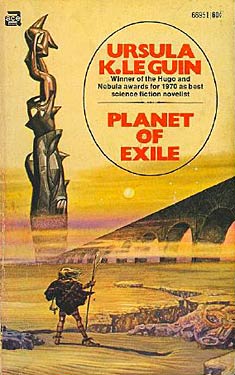 My last blog about Margaret Atwood and science fiction inadvertently led me back to Ursula K. Le Guin, who has been an important commentator on Atwood’s work. (See the comments to that blog to find some interesting links to Le Guin about Atwood and Atwood about Atwood.)
My last blog about Margaret Atwood and science fiction inadvertently led me back to Ursula K. Le Guin, who has been an important commentator on Atwood’s work. (See the comments to that blog to find some interesting links to Le Guin about Atwood and Atwood about Atwood.)
An omnibus edition of Le Guin’s works called Three Hainish Novels has been moving in and out of my to-be-read stack for more years than I’d like to admit. This edition contains the first three Hainish novels, Rocannon’s World (1966), Planet of Exile (1966), and City of Illusions (1967). I don’t know why I’ve not read these novels yet. My favorite book is The Left Hand of Darkness. (I know this because a colleague recently made me choose one book for a list he was putting together. It was very hard to choose, so I decided to pick the book that I had re-read more than any other. That was The Left Hand of Darkness.) When I read it in the late 80s, The Left Hand of Darkness changed the way that I thought about gender, writing, and science fiction. It even spurred me to do a research paper in a linguistics class about pronouns and gender. So, now, almost thirty years later, it’s time to finish the Hainish Cycle, beginning with these three novels. This blog will discuss the middle novel, Planet of Exile.
I like Soft SF, and I like world-building novels. And, lucky for me, so does Le Guin. She writes in her essay "Do-It-Yourself Cosmology":
As soon as you, the writer, have said, "The green sun had already set, but the red one was hanging like a bloated salami above the mountains," you had better have a pretty fair idea in your head concerning the type and size of green suns and red suns—especially green ones, which are not the commonest sort—and the arguments concerning the existence of planets in a binary system, and the probable effects of a double primary on orbit, tides, season, and biological rhythms; and then of course the mass of your planet and the nature of its atmosphere will tell you a good deal about the height and shape of those mountains, and so on, and on…. None of this background work may actually get into the story. But if you are ignorant of these multiple implications of your pretty red and green suns, you’ll make ugly errors, which every fourteen-year-old reading your story will wince at; and if you’re bored by the labor of figuring them out then surely you shouldn’t be writing science fiction. (The Language of the Night, 122)
This kind of specificity and willingness to play with the implications of physical systems allow Le Guin to create intriguing societies that relate to the attributes of the planet. For example, the properties of Werel, featured in Planet of Exile, will create very resilient cultures that are governed by seasonal rhythms:
The green third planet took sixty of Earth’s year’s to complete it year…. The winters of the northern hemisphere, tilted by the angle of the ecliptic away from the sun, were cold, dark, terrible: the vast summers, half a lifetime long, were measurelessly opulent. Giant tides of the planet’s deep seas obeyed a giant moon that took four hundred days to wax and wane. (City of Illusions 307)
Planet of Exile opens as this long, bitter winter comes, and one of the indigenous populations, the Tevarans, begins building its Winter City, a place where this agrarian culture will hunker down to outlast the raging winter and the raids of the nomadic culture, the Gaals, who always move south in winter. This hibernation of approximately fifteen Earth years is something the culture dreads and works to provide for throughout the rest of the long Werel year.
The fertility of the Tevarans is governed by the rhythm of the seasons. One is either Autumn-born or Spring-born. Rolery, a child born in the Summer, is out of sync with her people. Her Father, Wold, considers her place in this polygamous culture:
She looked to be about twenty moonphases old, which meant she was the one born out of season, right in the middle of the Summer Fallow when children were not born. The sons of Spring would by now be twice or three times her age, married, remarried, prolific; the Fall-born were all children yet. But some Spring-born fellow would take her for third or fourth wife; there was no need for her to complain. (Planet of Exile 150)
However, Rolery explains her situation differently:
[W]hen Winter’s over I’ll be too old to bear a Spring child. I’ll never have a son. Some old man will take me for a fifth wife one of these days, but the Winter Fallow has begun, and come Spring I’ll be old…. So I will die barren. It’s better for a woman not to be born at all than to be born out of season as I was. (Planet of Exile 150)
Rolery’s situation makes her an outsider in her own culture. She does not have an age cohort. Her loneliness fuels her curiosity about the other cultures that inhabit the planet. The book opens with Rolery brazenly entering the city of the farborns, the Alterran colonists who arrived six hundred years earlier and had lost contact with their empire, the League of All Worlds. Rolery wants to see the sea, so she travels through the Alterran city. She is almost caught by the fast moving tide, but is saved when the Alterran, Jakob Agat "bespeaks" her—he sends her a telepathic message to run.
 This encounter begins a relationship between Rolery and Jakob. Her situation as a Summer-born allows her to pursue this semi-taboo relationship. (Her father once had a farborn wife, but, of course, Wold is the tribe leader and a man.) Sexual relationships between Alterrans and the planet’s indigenous populations are sterile, but Rolery knows that she is doomed to barren relationships. Therefore, she chooses to become the first wife in a monogamous marriage rather than a later wife in a polygamous marriage.
This encounter begins a relationship between Rolery and Jakob. Her situation as a Summer-born allows her to pursue this semi-taboo relationship. (Her father once had a farborn wife, but, of course, Wold is the tribe leader and a man.) Sexual relationships between Alterrans and the planet’s indigenous populations are sterile, but Rolery knows that she is doomed to barren relationships. Therefore, she chooses to become the first wife in a monogamous marriage rather than a later wife in a polygamous marriage.
This "star-crossed lovers" plot is only a sub-plot in the novel. The real marriage happens between the Alterrans and the Tevarans, who must learn to rely on one another. Those pesky Gaals, who in the past had briefly harried the Winter Cities and the Alterran city as each nomadic group journeyed southward, have organized. Under the leadership of a Gaal Ghengis Khan, these hordes are moving southward as a conquering machine, burning cities, and stealing livestock and provisions. They leave death and destruction behind. Alterran scouts report this to Jakob, who must convince Wold and the Tevarans of the danger. His relationship with Rolery damages his credibility, and as a result of the Tevaran’s inaction their Winter City is destroyed by the Gaal. Alterran guerillas are able to save many of the Tevarans and bring them into their city. The long siege begins, and the Alterrans and the Tevarans have to learn how to live together.
The book is a fun and quick read. The romance is not overdone, and the cultures that Le Guin creates are developed and are not simply opposites of each other. Each culture demonstrates some interesting nuances that fit their unique situations. I think this novel is my favorite of the three. More on the other two in my next blog.
Philip K. Dickathon: Lies, Inc.
Guest Blogger and WWEnd Member, Charles Dee Mitchell, has contributed a great many book reviews to WWEnd and we’ve invited him to contribute to our blog. This is the latest in Dee’s series of Philip K. Dick reviews that he started on his blog www.potatoweather.blogspot.com. We’ll be posting one every week until he runs out of reviews or gets tired of Philip K. Dick books.
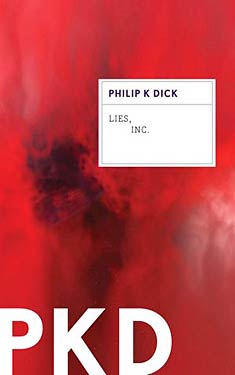 Over the past year I have read I think 15 Philip K. Dick novels in more or less chronological order. I have read some good ones, some bad ones, some sloppy ones, and a couple of brilliant ones. Lies, Inc., is the first I have read the pissed me off. A certain level of incoherency comes with the PKD territory, and keeping up with what he is thinking and typing furiously onto the page is part of the fun. But this time out, he creates an irritating mess.
Over the past year I have read I think 15 Philip K. Dick novels in more or less chronological order. I have read some good ones, some bad ones, some sloppy ones, and a couple of brilliant ones. Lies, Inc., is the first I have read the pissed me off. A certain level of incoherency comes with the PKD territory, and keeping up with what he is thinking and typing furiously onto the page is part of the fun. But this time out, he creates an irritating mess.
This novel had a chaotic publication history, and it’s problems stem from editors’ determination, early on with Dick’s approval, to make it into a book. In 1963 or 1964, PKD wrote, along with about a dozen other novels, The Unteleported Man, intended for Fantastic Stories or some other Ace Books outlet. (All this information comes from the afterward to the current edition of Lies, Inc., published by Vintage.) With the short novel already in hand, Donald Wolheim, publisher of Ace Books, received what he thought was a really cool cover painting and asked PKD to expand his novelette into book form so the cover might be used. PKD doubled the length of the novelette, but Wolheim, reportedly, was not pleased with Part Two. (If his reaction was indeed that mild, publishing, in the 1960’s, remained a “gentleman’s profession.”) Part One appeared in 1966 as part of an Ace Double. In 1979, now working with Berkeley Publishing, PKD had the idea of issuing the complete novel, although what he found of Part Two was missing around a dozen pages of text. PKD wrote a new opening, filled in most but not all of the gaps, and decided that Part Two, rather than succeeding Part One, should appear about halfway into Chapter 8 and end somewhere in Chapter 15. The book, retitled Lies, Inc., winds up in another 25 pages. It was not published until 1983, sixteen months of PKD’s death and melodramatically labeled “uncensored.”
All of the above is more interesting than anything else about the book. I will not pretend to summarize the plot, but Part Two has the main character appearing on another planet under the false identity that had been assigned to a different character. He is immediately injected with LSD, and PKD wallows in a hyperbolic description of the LSD experience for almost fifty pages. Somebody, more dedicated than myself, might dig up a copy of the short Unteleported Man and see if it makes sense. But Lies, Inc., spins so seriously out of control that I cannot even recommend it for PKD Completists. It is only for PKD Masochists.
GMRC Review: The Stainless Steel Rat
 Editor’s Note: On his blog Stainless Steel Droppings blogger Carl V. Anderson reviews SF/F books and movies, conducts author interviews and even hosts his own reading challenge: The 2012 Science Fiction Experience. What better book for his first Grand Master review than Harry Harrison’s The Stainless Steel Rat?
Editor’s Note: On his blog Stainless Steel Droppings blogger Carl V. Anderson reviews SF/F books and movies, conducts author interviews and even hosts his own reading challenge: The 2012 Science Fiction Experience. What better book for his first Grand Master review than Harry Harrison’s The Stainless Steel Rat?
James “Slippery Jim” diGriz is a master criminal, a stainless steel rat in the wainscoting of society, a society that is becoming increasingly devoid of crime thanks to the successful efforts of the galaxy’s infamous Special Corps. Cocky and self-assured, diGriz goes about his business with rare aplomb, each caper uniquely different so as to stay one step ahead of what passes for the law on whatever planet he happens to find himself located. When a particularly clever theft goes awry, Slippery Jim finds himself a cornered rat in a maze that lands him in the lap of the dreaded Special Corps.
And to make matters worse, the inmates are running the asylum, for the Special Corps is headed by none other than the most famous criminal mastermind ever: Harold Inskipp, aka Inskipp the Uncatchable. Soon DiGriz is presented with an offer he cannot refuse. As the old adage goes, “if you can’t beat ‘em, join ‘em”.
At any rate, it is better than having your mind wiped.
The first of Harry Harrison’s popular Stainless Steel Rat series was published in 1961, although portions of the story saw life in Astounding Science Fiction in 1957 and Analog: Science Fact and Fiction in 1960. Slippery Jim DiGriz is the prototypical anti-hero. Skilled in the art of crime and yet highly moralistic in his respect for life, DiGriz is a step nearer the heroic mold in comparison to those protagonists written by Alfred Bester, for example, in The Demolished Man or The Stars My Destination, and he is the precursor for loveable rogues like Han Solo or Malcolm Reynolds. In Jim DiGriz we see some of the vestiges of the chivalry and honor of the 1950’s coupled with the shifting changes in attitude about government that came about in the 1960’s. In addition The Stainless Steel Rat was somewhat prescient in showing a future where the free and casual use of drugs and alcohol was later born out in the late 60’s and in the 1970’s. In fact, The Stainless Steel Rat sits on a very interesting dividing line by including some of the older, now dated ideas that dominated science fiction in the 40’s and 50’s and other ideas about government and crime and the immensity of space that are relevant today.
In James DiGriz’s universe, a bank of psimen was used to send messages telepathically across light years and the future remained filled with a great deal of paper when it came to the wheels of bureaucracy. Computers used punch cards and destinations were laid into starships using course tapes. At the same time Harry Harrison envisioned space as the kind of massive place that even with largely populated galaxies an enormous warship could be impossible to find and envisioned a future in which women were every bit as clever and capable as men. All these things aside, what makes The Stainless Steel Rat a “vintage” novel that remains worth reading today is that it is a fast-paced, witty, fun story with just enough timely twists and turns that it remains satisfying from start to finish.
 Slippery Jim’s schemes are cunning in their planning and execution even when they do not work out entirely as orchestrated and he soon finds out that to be a really good cop in the Special Corps, it pays to keep the criminal skills in good working order. The Stainless Steel Rat is a quick read and I continue to find it absorbing enough that I wouldn’t hesitate to give it to any young boy or girl looking for a rollicking good science fiction adventure, nor to any adult wanting to read something fun with a hint of nostalgia to it. The story never flags, it is paced beautifully, and the dated elements never get in the way of the action.
Slippery Jim’s schemes are cunning in their planning and execution even when they do not work out entirely as orchestrated and he soon finds out that to be a really good cop in the Special Corps, it pays to keep the criminal skills in good working order. The Stainless Steel Rat is a quick read and I continue to find it absorbing enough that I wouldn’t hesitate to give it to any young boy or girl looking for a rollicking good science fiction adventure, nor to any adult wanting to read something fun with a hint of nostalgia to it. The story never flags, it is paced beautifully, and the dated elements never get in the way of the action.
I fell in love with the world of The Stainless Steel Rat as a pre-adolescent, when Slippery Jim and the lovely Angelina were the kind of characters who excited a young boy’s imagination and stirred his emotions. When I got older and picked up the book to read again I discovered that Harry Harrison did what many try to do and fail–he created an adventure/detective series set in a science fictional universe that has a timeless appeal because it is both smarter and better executed than many novels of the same mold that went before and have come after. Not all of the Stainless Steel Rat books are gems, but the first two especially (The Stainless Steel Rat and The Stainless Steel Rat’s Revenge) form a nice two-part tale that holds up well today from a pure enjoyment factor.
After 3+ decades of being a fan of his adventures, I readily admit to a bias towards (most of) Harry Harrison’s Stainless Steel Rat stories. Yet even in my fanatical devotion, witnessed by the title of my blog, I like to think that I have enough objectivity to see that there is really something here. There is a spark that good older science fiction stories have that keeps them popular to some degree today. Slippery Jim DiGriz will delight you with his escapades and you will walk away with a smile on your face, even if it is a wry smile.
H.P. Lovecraft: A Bit of a Pessimist
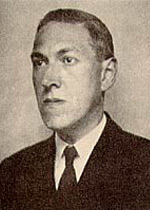 As part of our ongoing effort to underscore the classier side of genre literature, we’ve decided to keep pushing forward with our Genre Poetry series. We may be well out of the Month of Horrors, but that provides no safety from Friday the 13th! In keeping with the day’s traditional fears, this installment of Genre Poetry comes from the American patriarch of horror himself, H.P. Lovecraft, writing about what he knows best…
As part of our ongoing effort to underscore the classier side of genre literature, we’ve decided to keep pushing forward with our Genre Poetry series. We may be well out of the Month of Horrors, but that provides no safety from Friday the 13th! In keeping with the day’s traditional fears, this installment of Genre Poetry comes from the American patriarch of horror himself, H.P. Lovecraft, writing about what he knows best…
Despair
by H.P. LovecraftO’er the midnight moorlands crying,
Thro’ the cypress forests sighing,
In the night-wind madly flying,
Hellish forms with streaming hair;
In the barren branches creaking,
By the stagnant swamp-pools speaking,
Past the shore-cliffs ever shrieking;
Damn’d daemons of despair.Once, I think I half remember,
Ere the grey skies of November
Quench’d my youth’s aspiring ember,
Liv’d there such a thing as bliss;
Skies that now are dark were beaming,
Gold and azure, splendid seeming
Till I learn’d it all was dreaming—
Deadly drowsiness of Dis.But the stream of Time, swift flowing,
Brings the torment of half-knowing—
Dimly rushing, blindly going
Past the never-trodden lea;
And the voyager, repining,
Sees the wicked death-fires shining,
Hears the wicked petrel’s whining
As he helpless drifts to sea.Evil wings in ether beating;
Vultures at the spirit eating;
Things unseen forever fleeting
Black against the leering sky.
Ghastly shades of bygone gladness,
Clawing fiends of future sadness,
Mingle in a cloud of madness
Ever on the soul to lie.Thus the living, lone and sobbing,
In the throes of anguish throbbing,
With the loathsome Furies robbing
Night and noon of peace and rest.
But beyond the groans and grating
Of abhorrent Life, is waiting
Sweet Oblivion, culminating
All the years of fruitless quest.
(Thanks to the H.P. Lovecraft Archive for hosting this and so many other works from the author.)



















 Full Details
Full Details
